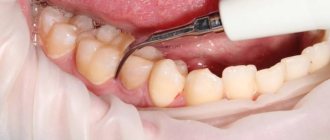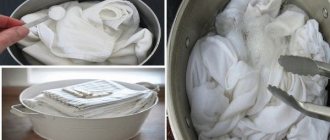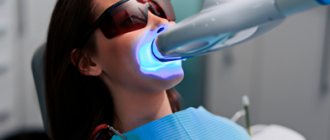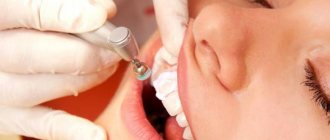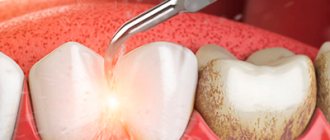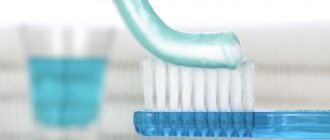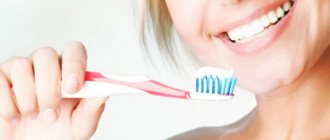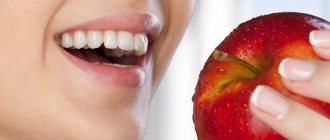Regular cleaning with baking soda
To quickly whiten your teeth, simply brush them with baking soda. Daily cleaning damages the enamel structure, so the procedure should be carried out no more than once every 4 months. You need to brush the enamel gently and carefully, without unnecessary friction, and those places where plaque has accumulated can be rubbed harder.
How to properly brush your teeth with baking soda to whiten them:
- Take a toothbrush with soft bristles and wet it.
- Dip the brush into the previously prepared baking soda.
- Start cleaning the enamel, carefully treat areas where plaque has accumulated.
- Rinse your mouth with warm water several times to flush out the soda.
- Brush your teeth again with whitening toothpaste.
Remember that if you naturally have weak enamel and sensitive teeth, then you cannot brush with soda. This method is traumatic for the gums, so do not allow soda to get on the mucous membrane.
Also keep in mind that baking soda only whitens teeth, not fillings. They are not bleached as they are initially a darker color and will look darker after cleaning. Under the influence of the active components of the mixtures, fillings can also be destroyed, so try not to bleach them too often.
Clinical researches
Clinical studies have proven that regular use of preventive toothpaste ASEPTA SENSITIVE for a month can reduce bleeding gums by 62%, reduce the sensitivity of teeth and gums by 48% and reduce inflammation by 66%.
Sources:
- Clinical studies of antisensitive toothpaste “Asepta Sensitive” (A.A. Leontyev, O.V. Kalinina, S.B. Ulitovsky) A.A. LEONTIEV, dentist O.V. KALININA, dentist S.B. ULITOVSKY, Doctor of Medical Sciences, Prof. Department of Therapeutic Dentistry, St. Petersburg State Medical University named after. acad. I.P. Pavlova
- The role of anti-inflammatory rinse in the treatment of periodontal diseases (L.Yu. Orekhova, A.A. Leontyev, S.B. Ulitovsky) L.Yu. OREKHOVA, Doctor of Medical Sciences, Prof., Head of Department; A.A. LEONTIEV, dentist; S.B. ULITOVSKY, Doctor of Medical Sciences, Prof. Department of Therapeutic Dentistry of St. Petersburg State Medical University named after. acad. I. P. Pavlova
- Report on determining/confirming the preventive properties of commercially produced personal oral hygiene products: Asepta toothpaste used in combination with Asepta mouthwash and Asepta gum balm Head. Department of PFS Doctor of Medical Sciences Professor S.B. Ulitovsky St. Petersburg State Medical University named after Academician I.P. Pavlova. Faculty of Dentistry. Department of Preventive Dentistry.
Soda and lemon
There is another recipe for a brightening solution based on lemon and soda. This mixture is strictly contraindicated for people with sensitive and thin enamel. Even healthy teeth can become sore after the procedure.
To whiten teeth with soda and lemon juice, you will need a tablespoon of baking soda and the juice of half a lemon. Mix ingredients in a glass or porcelain container. Wait. While the baking soda and lemon react, stir the mixture and simply brush your teeth with the resulting solution.
How does baking soda affect teeth?
Soda is a good and inexpensive disinfectant. Even now, doctors recommend using it in dental treatment of infants who are diagnosed with stomatitis or oral thrush.
Soda kills fungus and promotes rapid healing of ulcers on the mucous membrane that appear as a result of stomatitis due to its high regenerative properties. In addition, sodium bicarbonate has a pronounced anti-inflammatory effect. Dentists often prescribe rinses or baths with soda or soda-saline solution for purulent periodontitis and pulpitis, after opening the cavity of the affected tooth.
In America, clinical observations of the oral health of patients using soda pastes for brushing their teeth and microbiological analyzes of the contents from the oral cavity of these patients showed that the concentration of pathogenic microorganisms is significantly reduced.
Whitening effect of brushing teeth with baking soda
As for hard tooth tissues, soda has a good whitening effect . The enamel is lightened by at least 0.5 shades, which can be compared with professional oral hygiene. This happens thanks to abrasive particles that efficiently clean the tooth surface from dental plaque and food debris. Conventionally, you can compare brushing your teeth with soda to cleaning various surfaces with sandpaper.
American scientists even conducted a study in 2008 that showed that pastes based on baking soda are much better at removing dental plaque than pastes with a soda-free composition or a low concentration.
It is necessary to take into account the fact that soda is a pure abrasive. Abrasive particles are found in many toothpastes, especially whitening ones. Dentists do not recommend using whitening toothpastes for longer than 2 weeks, because... abrasive particles can thin the enamel layer of the tooth, leading to hypersensitivity. For this reason, pure abrasive in the form of baking soda definitely cannot be used often . Dentists also do not recommend using soda in dry, undiluted form.
You also need to pay attention to the pH of the soda. It is equal to 8, which is typical for an alkaline environment. Many people are afraid of this indicator, but it is only dangerous for the protective barrier of the skin, which is manifested by redness around the mouth if soda pastes act on the skin for a long time. For the oral cavity, an alkaline environment, on the contrary, is positive, because it neutralizes acidity. It is high acidity that contributes to the destruction of hydroxyapatites in the enamel, which act as a kind of skeleton, thereby disrupting the structure of hard tissues and provoking the development of caries and its complications in the future.
Soda teeth whitening:
The benefits and harms of cleaning
Only baking soda is suitable for teeth!
The advantages of sodium bicarbonate pastes include:
- Achieving a positive result quickly, the enamel becomes lighter after the first procedure.
- Easy to prepare pasta and use it.
- Removal of all dental plaque.
- Low cost.
- Relief of unpleasant odor from the oral cavity.
- Relief of inflammatory processes in the oral cavity.
- Accelerated healing of wounds in the mouth.
- Neutralization of acidity in the mouth.
- Destruction of pathogenic microorganisms and fungi of the genus Candida that cause candidiasis (thrush).
There are also disadvantages :
- High abrasive properties. Frequent use of soda contributes to the thinning of the enamel layer and the development of the carious process in the future.
- Irritating effect on soft tissues in the form of red spots or rashes around the mouth.
- Risk of developing bleeding gums.
- The appearance of sensitivity to hot, cold and sour with frequent use of the soda bleaching procedure.
- The short duration of the achieved result.
Important! To prevent the development of these shortcomings, it is not recommended to use products with sodium bicarbonate more than once every 3-4 weeks.
Soda with turmeric and peroxide
There is another great recipe for whitening teeth with baking soda.
, but before you try, listen carefully to all the contraindications.
- If you have very sensitive and thin enamel, then this method will definitely not suit you.
- Another contraindication will be pregnancy and lactation.
- Until the age of 18, teeth have not yet fully developed and they cannot be whitened because they can be damaged.
- Also, bleaching is not recommended while taking antibiotics.
If there are no contraindications and you urgently need to get your smile in order, as an exception, you can whiten your teeth with soda at home. Remember that you cannot whiten your teeth more often than once every 3-4 months. If you do this more often, then after a while you will simply be left without enamel.
Preparing the mixture
For this method you will need a special mixture; we will prepare it in two stages. All components have long been known - these are turmeric, salt, soda, toothpaste and hydrogen peroxide.
| Turmeric | A common seasoning that you definitely have in your kitchen. You will need about half a teaspoon. |
| Soda | Add one teaspoon. The soda must be baking soda. Never use baking soda that you add to laundry or to clean dishes, it will harm your health. |
| Salt | The finer the salt, the better. If you have coarse salt, for example sea salt, then you need to grind it in a coffee grinder. You will also need half a teaspoon of salt. |
| Toothpaste | It is better to take whitening toothpaste to achieve better results. You will need a little paste, a piece the size of a bean. |
| Peroxide | It is better to take 3% hydrogen peroxide in the form of a sealed tube, since the product in jars quickly runs out. Add peroxide by eye, enough to thicken the mixture. |
First you need to mix turmeric, salt and soda in a small glass container, maybe in a glass. Next, head to the bathroom to finish the recipe and start cleaning right away. The fact is that you need to add peroxide at the very last moment so that it does not run out while you are preparing your teeth for the procedure.
Add the remaining ingredients and stir the mixture thoroughly. To make it less vigorous, you can add a couple of drops of water. This is really a very tough recipe, so you can whiten your teeth with soda infrequently, once every 3-4 months is enough. Before applying the mixture, you need to brush your teeth with whitening paste or regular one.
How to bleach correctly
The finished whitening agent must be applied to the inside and outside of the teeth. It is better to apply the mixture with another brush, because it will turn yellow with turmeric. It is important to be very careful and try not to get it on your gums. Peroxide, turmeric and salt contribute to irritation of the mucous membrane, so the gums can then become hot.
The mixture tastes quite unpleasant, but you will need to walk with it for 3 minutes. Next, you can rinse your mouth, take the whitening mixture again and brush your teeth with it. This should be done very easily and carefully, preferably with a soft brush so as not to scratch the enamel. Rinse your mouth with water again.
The last stage is repeated brushing with a regular whitening paste. We fix the result with a special teeth rinse, if you have one.
You will notice the effect immediately after the first use, your smile will brighten. It will not become snow-white, because all products bleach only to a natural color, and homemade recipes do not even give such a result. The expected result is that brushing with soda helps whiten teeth by only 1-2 shades.
Myths about teeth
Myths about teeth brushing and whitening
1. Teeth can be whitened with a special toothpaste. This is wrong . Bleaching pastes containing abrasive materials can only remove staining from nicotine or food. Such toothpastes will not be able to make teeth whiter than they were intended by nature. Real teeth whitening is done only in dental clinics , using hydrogen peroxide or carbamide peroxide compounds.
2. To make your teeth whiter, you need to brush them with baking soda. In fact, soda has a very high abrasiveness, much higher than permissible. Therefore, brushing your teeth with soda will cause it to scratch and eventually remove the enamel of your teeth . Soda is contraindicated for any type of periodontitis.
3. Brushing your teeth is generally harmful, as it wears away the enamel. If you do not brush your teeth , soft plaque forms on them , which first contributes to the development of caries , and then the formation of tartar.
4. Teeth need to be brushed only 2 times a day. It's minimum. The amount of brushing depends on the nature of the food, the amount of plaque and the general condition of the body.
5. Brushing your teeth should be done after breakfast. Yes, you really need to brush your teeth after eating. But in the morning it is better to brush your teeth before eating , immediately after waking up - this prevents the bacteria that formed in the oral cavity overnight from developing and prevents bacteria from entering the stomach during meals.
Myths about toothache
6. If you have a toothache, apply cotton wool with alcohol or crushed aspirin to the tooth. It is very dangerous. This will not make a sick tooth feel any better, but if held for a long time, it will burn the mouth.
7. For toothache, you need to apply garlic to your wrist. This is how a certain group of sectarians were treated. Their faith in this method helped them. You can try it too.
8. If your teeth don’t hurt, then you don’t need to go to the dentist. As a rule, diseases of the oral cavity initially occur painlessly . In addition, in the early stages the disease is much easier to cure. Therefore, you must visit the dentist twice a year.
9. Any visit to the dentist is scary and painful. This is wrong. Dentistry today means modern treatment methods, clinics are equipped with silent devices and a variety of painkillers.
Myths about bite correction and braces
10. You can correct your bite at any age. This is only true if one or two teeth need to be corrected . If the bite is disturbed due to the characteristics of the maxillofacial apparatus, then each specific case should be discussed with an orthodontist.
11. The bite should be corrected after replacing all baby teeth with molars. It is better to visit an orthodontist when the child is three years old. If a child sucks a finger or pacifier for a long time, it is better to visit an orthodontist before the age of three. This will prevent the development of malocclusions and premature removal of baby teeth.
12. Correcting a child’s bite is expensive. There is some truth. The services of an orthodontist are not cheap. But if we take into account that an incorrect bite leads to a violation of the chewing function, therefore, disorders of the gastrointestinal tract, diseases of the teeth and gums, then by correcting an incorrect bite as early as possible, it will be possible to get by with small losses of money.
13. It takes a long time to get used to braces. This is wrong. Getting used to it lasts one to two weeks. In the first days after installation, pressure is felt on the teeth. Subsequently, braces do not interfere even when playing wind instruments.
14. Braces damage tooth enamel. Between the bracket and the tooth there is a special material that releases fluoride and strengthens the enamel. Tooth enamel can be worsened by insufficient hygiene when wearing braces or eating foods prohibited by the orthodontist. It is necessary to follow all the doctor’s recommendations and take care of your teeth more carefully than before installing braces.
15. Wearing braces is not attractive. It is much uglier to have uneven teeth. And you can choose braces to suit every taste - silver, sapphire, ceramic, plastic, lingual.
Myths about prosthetics and implantation
16. When installing a crown on a tooth, the nerve must be removed. Not anymore. Modern technologies in dentistry make it possible to treat a tooth and prepare it for prosthetics without resorting to nerve removal. When processing a tooth, a minimal amount of its tissue is removed, and after grinding the tooth is coated with a special agent that reduces its sensitivity.
17. Gold never causes allergies in the oral cavity. It is a myth. Everything is very individual . Some people may experience inflammation where gold crowns touch the oral mucosa.
18. It is not at all necessary to place an implant if there is no tooth. On the contrary, it is very necessary. When a tooth is missing, the bone tissue of the jaw deteriorates , pits and cavities form, the load on the remaining teeth increases, but the quality of chewing suffers, and this is fraught with diseases of the gastrointestinal tract. Well, in the end, a person with a full row of teeth has a more aesthetic appearance.
Myths about tooth extraction
19. It is cheaper to remove a diseased tooth than to treat it. It depends on situation. If there are no direct indications for tooth extraction, it must be preserved and cured. The tooth extraction itself can indeed be much cheaper, but as we have already stated above, there should not be empty spaces in the mouth. But dental implantation will still cost more than treating your own tooth.
20. A diseased tooth must be treated until the last minute and under no circumstances should it be removed. Of course, tooth extraction is far from the best option, but a diseased tooth is a source of infection , which also adversely affects the health of the body. Everything is very individual. There are cases when a seemingly non-viable tooth can be cured, but a seemingly healthy tooth has to be removed.
21. After tooth extraction, the oral cavity must be thoroughly disinfected. This is true, but you must not overdo it so as not to wash the blood clot out of the wound. It helps in better healing. So it’s better not to touch this place for 2-3 days.
Myths about treating children
22. Any dentist, not necessarily a pediatric dentist, can treat a child’s teeth. Treatment methods for children's and adult teeth are different. This is due to the presence of baby teeth in children and the resorption of their roots. And it is the pediatric dentist who is more qualified to possess this information. In addition, the cost of pediatric dentistry is cheaper.
23. It is necessary for the child to be afraid of dentists, then he will take better care of his teeth. There is a chance that the child will brush his teeth well often, but psychological fear of dental treatment will be more of an enemy than a helper . Because you will still have to treat your teeth sooner or later in life. It is better to visit the dentist with your child 2 times a year so that he gets used to the fact that this procedure is not scary, but necessary.
24. There is no need to treat baby teeth; they will fall out anyway. This is a very harmful misconception for children's health. Untreated baby teeth lead to problems with molars. Extracted baby teeth disrupt the bite prematurely.
25. Sweets are bad for your teeth. Not all sweets. Chocolate, for example, contains cocoa beans, which have an antimicrobial effect and protect teeth from caries. But this does not mean that you should not brush your teeth after eating chocolate or consume it in moderation. It is better to drink carbonated drinks through a straw to reduce the contact of the liquid with the enamel of the teeth.
Other myths
26. Traumatic periodontitis can occur only after an injury (bruise, blow).
The most common causes of this disease are not injuries, but, for example, regular pressure on the teeth from the mouthpiece of a smoking pipe or musical instrument. It’s also a good idea to get rid of bad habits - biting threads, pressing on a tooth with a pencil or pen, shelling seeds, etc.
27. Trigeminal neuralgia occurs during a cold. No. Trigeminal neuralgia is viral in nature and manifests itself as herpetic rashes on the skin of the face, although a cold provokes this disease. The first thing to do at the first signs of neuralgia is to get rid of the virus, i.e. if the disease becomes chronic, a post-herpetic pain phenomenon may develop, and it will have to be treated with anticonvulsants.
Why is home whitening worse?
Many people prefer homemade recipes to salon teeth whitening treatments. Indeed, why spend money and do whitening procedures with a soda machine in the dentist’s chair if you yourself know how to whiten teeth with soda. In fact, it turns out that no matter how effective home recipes are, professional cleaning is better and safer.
Baking soda contains larger particles and is therefore more abrasive. In combination with a hard brush, it can damage the enamel. During a similar procedure in the office, dentists do not always use baking soda. Calcium carbonate powder and glycine powder are used, each with a different abrasiveness and purpose.
During the procedure, dentists use a special hydraulic device, which reduces the abrasiveness of soda using a jet of water. Hydraulic cleaning helps to penetrate hard-to-reach areas and remove plaque even between teeth and under the gums.
After cleaning with a soda machine, the enamel surface must be polished. If this is not done, it will become porous and will collect plaque even faster.
Baking soda itself does not help whiten teeth; it only removes pigmented plaque from the surface of the enamel. With frequent and unprofessional use, soda can damage the enamel, but, unfortunately, it is not restored.
Rules of application
To achieve white teeth without damaging the enamel layer of the tooth, you need to use sodium bicarbonate a maximum of once a month. In this case, you need to use it mixed with water, the consistency should be mushy. You can use any other solvent.
Attention! Do not use dry soda under any circumstances; it can leave scratches on the enamel layer.
This is what the paste should look like
In addition, dry soda powder feels like sand in the mouth, which causes discomfort. It is better to use the product in diluted form, mixing it with toothpaste or other substance.
There are several proven recipes for preparing homemade soda pastes and solutions, which will be discussed below.
The method of brushing your teeth can be standard, but it is better to use circular movements of the brush. This will not only clean the tooth surfaces, but also massage the gums, improving tissue trophism.
Effect
The result of using a homemade paste based on sodium bicarbonate is noticeable after the first cleaning. The enamel is lightened by at least 0.5 tones. At the same time, soda can cope not only with soft plaque.
Before and after teeth whitening with baking soda
The paste also effectively removes pigmented plaque and tartar. However, the effect is short-lived . The enamel returns to its original shade after 2 – 3 days.
Video review of brushing teeth with soda:
Contraindications
Unfortunately, brushing your teeth with soda powder is not suitable for everyone; in the following cases, it is wiser to avoid it:
- allergic reactions, as well as individual intolerance of the body;
- sensitive and weak enamel, unstable to mechanical and chemical influences. In this case, brushing your teeth will only make the problem worse;
- the presence of acute inflammatory processes in the oral cavity. Even if the doctor has approved rinsing with soda, it is better to avoid direct cleaning. This is especially true for irritated gums, as well as injuries and small wounds;
- the presence of brackets, dental retainers and other instruments attached with glue. Soda destroys the glue and loosens the fasteners.
What benefits does baking soda bring to teeth?
From a chemical point of view, soda is an alkali , and this substance helps restore normal acidity in the mouth and prevent the growth of bacteria. Interacting with water, soda forms a dense foam, so the solution is able to penetrate into the gap between the teeth, under the papillae of the tongue and into other hard-to-reach places, pushing out contaminants from there.
Soda itself is an antibacterial and antiseptic , so it is used for rinsing during infections, fungal diseases of the oral cavity, for the prevention of sore throat, and for stomatitis. Such treatment should be prescribed by a doctor, because not in all cases soda is a suitable remedy.
The abrasive properties of sodium bicarbonate crystals help remove plaque or stains from teeth. When used carefully, it can clean and brighten teeth, keeping them healthy for longer.
Soda solution brings a comprehensive effect on oral care:
- Eliminates food debris and unpleasant plaque.
- Normalizes acid-base balance.
- Freshens breath by eliminating bacterial odor.
- Removes the dark layer from the surface of the teeth.
- Relieves inflammatory processes.
- Accelerates the healing of damage in the oral cavity.
- Has a preventive effect in the fight against caries and tartar.
However, all these comments are valid only if you use a mild soda solution with moderate frequency.
Is it possible to brush your teeth with baking soda every day?
Dentists have a negative attitude towards any abrasive products, therefore, from a professional point of view, daily brushing of teeth with soda is prohibited. It was already mentioned above that daily use leads to destructive processes in tooth tissue, but people still strive to achieve positive dynamics and consolidate this result for a long time.
Carefully! It is impossible to achieve a lasting result with whitening soda. Excessive efforts will lead to other dental problems that cannot be treated at home.
The effect after brushing teeth with soda does not last long, which explains the desire of patients to use this method of hygiene more often. However, daily use thins the enamel more and more. Dentin, which is much darker, begins to appear through the thin enamel layer.
As a result, the teeth become even darker than they were before and it will no longer be possible to achieve lightening at home. In addition, thin enamel easily allows waste products of pathogenic microflora, which are the source of the development of most dental diseases, to pass through it.
Dentist on brushing teeth with soda:
Is it possible to brush your child's teeth with baking soda?
It is better not to brush teeth with a milk bite with soda. There are several reasons for this:
- The enamel is already white and does not need bleaching.
- The enamel is not fully formed and is very porous, which can contribute to its rapid destruction.
